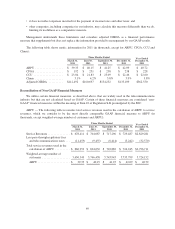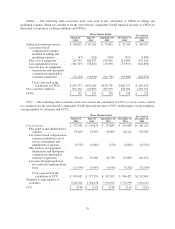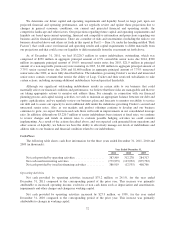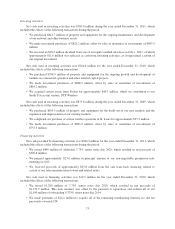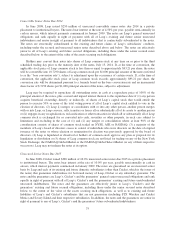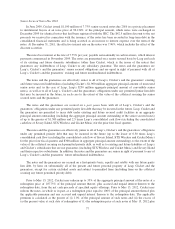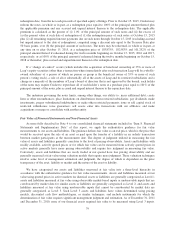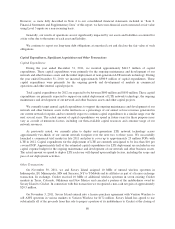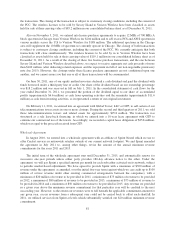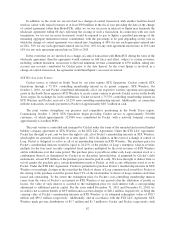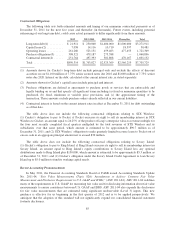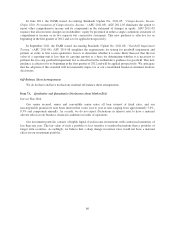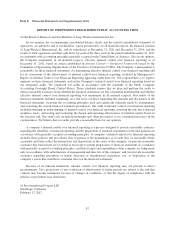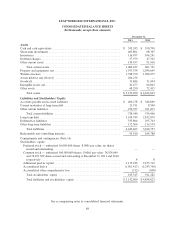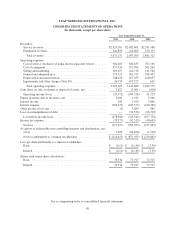Cricket Wireless 2011 Annual Report Download - page 89
Download and view the complete annual report
Please find page 89 of the 2011 Cricket Wireless annual report below. You can navigate through the pages in the report by either clicking on the pages listed below, or by using the keyword search tool below to find specific information within the annual report.redemption date, from the net cash proceeds of specified equity offerings. Prior to October 15, 2015, Cricket may
redeem the notes, in whole or in part, at a redemption price equal to 100% of the principal amount thereof plus
the applicable premium and any accrued and unpaid interest thereon to the redemption date. The applicable
premium is calculated as the greater of (i) 1.0% of the principal amount of such notes and (ii) the excess of
(a) the present value at such date of redemption of (1) the redemption price of such notes at October 15, 2015
plus (2) all remaining required interest payments due on such notes through October 15, 2015 (excluding accrued
but unpaid interest to the date of redemption), computed using a discount rate equal to the Treasury Rate plus
50 basis points, over (b) the principal amount of such notes. The notes may be redeemed, in whole or in part, at
any time on or after October 15, 2015, at a redemption price of 103.875%, 102.583% and 101.292% of the
principal amount thereof if redeemed during the twelve months beginning on October 15, 2015, 2016 and 2017,
respectively, or at 100% of the principal amount if redeemed during the twelve months beginning on October 15,
2018 or thereafter, plus accrued and unpaid interest thereon to the redemption date.
If a “change of control” occurs (which includes the acquisition of beneficial ownership of 35% or more of
Leap’s equity securities (other than a transaction where immediately after such transaction Leap will be a wholly-
owned subsidiary of a person of which no person or group is the beneficial owner of 35% or more of such
person’s voting stock), a sale of all or substantially all of the assets of Leap and its restricted subsidiaries and a
change in a majority of the members of Leap’s board of directors that is not approved by the board), each holder
of the notes may require Cricket to repurchase all of such holder’s notes at a purchase price equal to 101% of the
principal amount of the notes, plus accrued and unpaid interest thereon to the repurchase date.
The indenture governing the notes limits, among other things, our ability to: incur additional debt; create
liens or other encumbrances; place limitations on distributions from restricted subsidiaries; pay dividends; make
investments; prepay subordinated indebtedness or make other restricted payments; issue or sell capital stock of
restricted subsidiaries; issue guarantees; sell assets; enter into transactions with our affiliates; and make
acquisitions or merge or consolidate with another entity.
Fair Value of Financial Instruments and Non-Financial Assets
As more fully described in Note 4 to our consolidated financial statements included in “Item 8. Financial
Statements and Supplementary Data” of this report, we apply the authoritative guidance for fair value
measurements to our assets and liabilities. The guidance defines fair value as an exit price, which is the price that
would be received upon the sale of an asset or paid upon the transfer of a liability in an orderly transaction
between market participants at the measurement date. The degree of judgment utilized in measuring the fair
value of assets and liabilities generally correlates to the level of pricing observability. Assets and liabilities with
readily available, actively quoted prices or for which fair value can be measured from actively quoted prices in
active markets generally have more pricing observability and require less judgment in measuring fair value.
Conversely, assets and liabilities that are rarely traded or not quoted have less pricing observability and are
generally measured at fair value using valuation models that require more judgment. These valuation techniques
involve some level of management estimation and judgment, the degree of which is dependent on the price
transparency of the asset, liability or market and the nature of the asset or liability.
We have categorized our assets and liabilities measured at fair value into a three-level hierarchy in
accordance with the authoritative guidance for fair value measurements. Assets and liabilities measured at fair
value using quoted prices in active markets for identical assets or liabilities are generally categorized as Level 1;
assets and liabilities measured at fair value using observable market-based inputs or unobservable inputs that are
corroborated by market data for similar assets or liabilities are generally categorized as Level 2; and assets and
liabilities measured at fair value using unobservable inputs that cannot be corroborated by market data are
generally categorized as Level 3. Such Level 3 assets and liabilities have values determined using pricing
models, discounted cash flow methodologies, or similar techniques, and include instruments for which the
determination of fair value requires significant management judgment and estimation. As of December 31, 2011
and December 31, 2010, none of our financial assets required fair value to be measured using Level 3 inputs.
79


